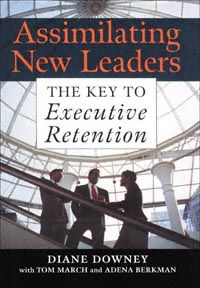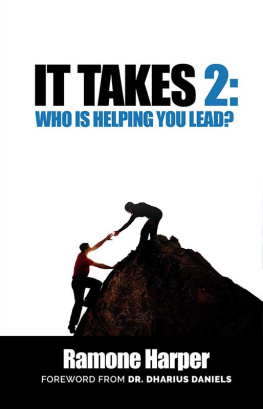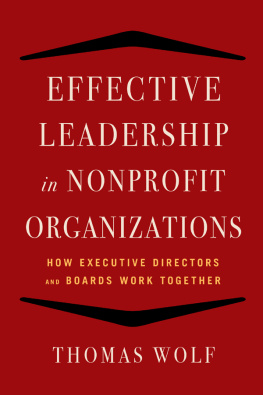Cover

| title | : | Assimilating New Leaders : The Key to Executive Retention |
| author | : | Downey, Diane.; March, Tom.; Berkman, Adena. |
| publisher | : | AMACOM Books |
| isbn10 | asin | : | 0814406459 |
| print isbn13 | : | 9780814406458 |
| ebook isbn13 | : | 9780814426210 |
| language | : | English |
| subject | Leadership, Executive ability, Employee retention. |
| publication date | : | 2001 |
| lcc | : | HD57.7.D69 2001eb |
| ddc | : | 658.4/0714 |
| subject | : | Leadership, Executive ability, Employee retention. |
Page i
ASSIMILATING
NEW LEADERS
Page ii
Page iii
ASSIMILATING
NEW LEADERS
The Key to Executive Retention
D I A N E D O W N E Y with T O M M A R C H and A D E N A B E R K M A N
AMACOM
A m e r i c a n M a n a g e m e n t A s s o c i a t i o n
New York Atlanta Boston Chicago Kansas City San Francisco Washington, D. C. Brussels Mexico City Tokyo Toronto
Page iv
| Special discounts on bulk quantities of AMACOM books are available to corporations, professional associations, and other organizations. For details, contact Special Sales Department, AMACOM, a division of American Management Association, 1601 Broadway, New York, NY 10019. | | Tel.: 212-903-8316. Fax: 212-903-8083. | | Web site: www.amacombooks.org |
|
This publication is designed to provide accurate and authoritative information in regard to the subject mattercovered. It is sold with the understanding that the publisher is notengaged in rendering legal, accounting, or other professional service.If legal advice orother expert assistance is required, the services of acompetent professional person should be sought.
Library of Congress Cataloging-in-Publication Data
Downey, Diane.
Assimilating new leaders: the key toexecutive retention /Diane Downey,Tom March, Adena Berkman.
p. cm.
Includes bibliographical references.
ISBN 0-8144-0645-9
1. Leadership. 2. Executive ability.3. Employee retention.I. March, Tom. II. Berkman, Adena. III. Title.
HD57.7 .D69 2001
658.4'0714dc21
2001022183
2001 Downey AssociatesInternational, Inc.
All rights reserved.
Printed in the United States of America.
This publication may not be reproduced, stored in a retrieval system, or transmitted in whole or in part, in any form or by any means, electronic, mechanical, photocopying, recording, or otherwise, without the prior written permission of AMACOM, a division of AmericanManagement Association, 1601 Broadway, New York, NY 10019.
Printing Number
10 9 8 7 6 5 4 3 2 1
Page v
F O R O U R P A R E N T S
Gerda and Ernest Martel
Dawn and Tom March
Louise and Jerry Berkman
Page vi
Page vii
Contents
Acknowledgments | ix |
Introduction | |
|
|
| P A R T O N E |
|
| SETTING THE STAGE FOR SUCCESSFUL ASSIMILATION |
|
Chapter 1: The Business Case for ExecutiveAssimilation | |
Chapter 2: Reciprocal Impact: A New Assimilation Model | |
Chapter 3: Determining Assimilation Potential | |
|
|
| P A R T T W O |
|
| THE ASSIMILATION PROCESS |
|
Chapter 4: Stage One: Anticipatingand Planning | |
Chapter 5: Stage Two: Entering andExploring | |
Chapter 6: Stage Three: Building | |
Chapter 7: Stage Four: Contributing | |
|
Appendixes | |
A: The New Leader's Handbook | |
B: Organizational Checklists: Overview ofthe AssimilationProcess | |
|
Bibliography | |
Index | |
|
Page viii
Page ix
Acknowledgments
Although the cover indicates that this book was written with Tom March and Adena Berkman, they were genuine intellectual partners throughout the process of researching and writing this book. As DAI consultants and writing partners, they contributed key concepts and were responsible for writing large parts of the book.
Tom has collaborated on a number of new leader assimilation programs for DAI clients during his two years at the firm. His experience as a writer had an enormous impact on the shape and direction of the book. In addition to his work on new leader assimilation, he has assisted DAI clients in the design and delivery of change interventions in both the profit and nonprofit sectors. Prior to joining DAI, he taught at Fordham University, St. John's University, and Rutgers University-Newark. He completed his doctorate at New York University.
Adena's knowledge and experience identifying and addressing turnover issues while a consultant in the office of retention at Ernst & Young Australia added significantly to the depth and richness of our ideas. Adena's logical thinking and commitment to providing structure proved invaluable to the refinement and enhancement of our writing. Before joining DAI, Adena worked as a consultant with a number of multinational organizations in such areas as HR transformation and change management. Adena has an M.A. in Clinical Psychology from Yeshiva University and an M.A. in Organizational Psychology from Columbia University.
We wish to thank our colleagues at Downey Associates International, Inc. As with most DAI projects, this was truly a team initiative. The senior consultants contributed their client experiences and others assisted in researching and editing. We particularly want to thank Sheila Oh for helping to rewrite several chapters; Glen Alcantara for his creative contribution and critical thinking; Jenny Martel for her hours of research and tracking of obscure references; Navid Rahmanim for his computer expertise and development of our assimilation Web site, acces
Page x
sible at executiveassimilation.com or newleaderassimilation.com; and Mark Watson for his administrative support and dedication to the details.
We are particularly indebted to Joel Ospa, Managing Director at Goldman Sachs Investment Management Division, for his insights and ideas. We also thank the following colleagues who have offered their insight to us throughout the process of writing this book: Lourine Clark, Linda Crill, Jim Dickinson, Michele DiMartino, Paul Erickson, Inez Janger, Pat Lammers, Margaret Llamas, Les Martel, Rob Reid, David Rodriguez, Martha Sherman, Dennis Shiel, and Scott Stanley. Thank you to Adrienne Hickey, our editor, for her patience and guidance.
Next page









